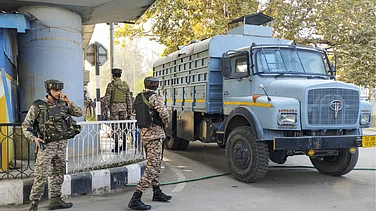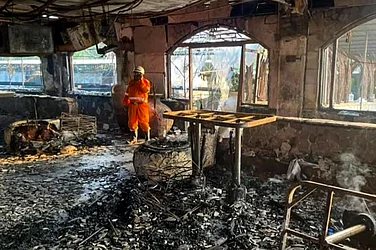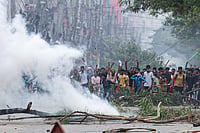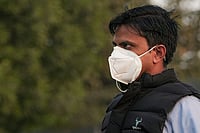A torrid heatwave sent the mercury soaring across large swathes of the country on Friday, with Banda in east Uttar Pradesh logging a record high of 47.4 degrees Celsius for April, besides many other places also registering all-time high temperatures for the month.
The mercury breached the 46-degree Celsius mark in several places. Allahabad, Jhansi and Lucknow in Uttar Pradesh recorded all-time high temperatures for April at 46.8 degrees Celsius, 46.2 degrees Celsius and 45.1 degrees Celsius respectively.
Gurugram in Haryana and Satna in Madhya Pradesh also recorded their respective all-time highs for the month at 45.9 degrees Celsius and 45.3 degrees Celsius.
Among other places, Delhi's Sports Complex observatory recorded a maximum temperature of 46.4 degrees Celsius, Rajasthan's Ganganagar 46.4 degrees Celsius, Madhya Pradesh's Nowgong 46.2 degrees Celsius and Maharashtra's Chandrapur 46.4 degrees Celsius.
Delhi's Safdarjung Observatory, the national capital's base station, recorded a maximum temperature of 43.5 degrees Celsius for the second day on the trot.
It is the highest maximum temperature for a day in April in 12 years in the city. Delhi had recorded a maximum temperature of 43.7 degrees Celsius on April 18, 2010.
The India Meteorological Department (IMD) said the heatwave spell will persist over northwest and central India till May 2 and over east India till April 30.
"Heat wave conditions: in some parts over West Rajasthan during 29th-30th April with Severe Heat Wave Conditions on 01st May and gradually decrease into Heat Wave conditions in isolated pockets on 02nd May", tweeted IMD.
An 'orange alert' has been issued for Haryana, Punjab, Delhi, Uttar Pradesh, Rajasthan, Madhya Pradesh, Jharkhand, and the Vidarbha region of Maharashtra for Saturday.
The IMD uses four colour codes for weather warnings. Green means no action is needed, yellow refers to watch and stay updated, orange means be prepared and red alert means take action.
The heatwave is expected to abate from Monday under the influence of a western disturbance, which is likely to affect northwest India from the night of May 1, it said.
Rajasthan, Delhi, Punjab and Haryana may witness light rainfall and thunderstorm between May 2 and May 4. The maximum temperatures will be between 36 degrees Celsius and 39 degrees Celsius, senior scientist R K Jenamani said.
The IMD said the intense heat could lead to "moderate" health concerns for the vulnerable sections such as infants, the elderly and people with chronic diseases.
"Hence people should avoid heat exposure, wear lightweight and light-coloured cotton clothes and cover their heads with a hat or an umbrella," it said.
There is an increased likelihood of symptoms of heat illness in people who are either exposed to the sun for a prolonged period or doing heavy work, an IMD advisory read.
Vidarbha in Maharashtra and west Rajasthan have consistently reported maximum temperatures in the range of 40 degrees Celsius to 45 degrees Celsius for the past two months.
According to an analysis by green thinktank Centre for Science and Environment, the early heatwaves that began on March 11 have impacted 15 Indian states and union territories (as of April 24).
According to D Sivananda Pai of the Kottayam-based Institute for Climate Change Studies, anti-cyclones over western parts of Rajasthan in March and the absence of western disturbances had triggered the early and extreme heatwaves. Anticyclones cause hot and dry weather by sinking winds around high-pressure systems in the atmosphere.
As the heatwave continued to intensify, the country's peak power demand met touched an all-time high of 207.11 GW on Friday while the railways cancelled 42 passenger trains to facilitate coal freight movement, with South East Central Railway (SECR) division that covers the coal-producing regions cancelling 34 trains.
Latest data from the Central Electricity Authority (CEA) showed that coal stocks at 147 non-pit head plants monitored by it was 24 per cent of the normative level on April 27 and 28. It was 25 per cent of normative level on April 26.
Non-pithead plants are situated hundreds of kilometres away from thermal power plants and maintaining required coal stocks for those is essential for power generation.
The all India peak power demand met or highest supply in a day touched 207.11 GW on Friday, an all-time high. The same was at 204.65 GW and peak deficit at 10.77 GW on Thursday.
The peak deficit figure for Friday was not immediately available. Peak deficit has been increasing this week. It was at 5.24GW on Monday, 8.22GW on Tuesday and 10.29GW on Wednesday.
(With PTI Inputs)


























